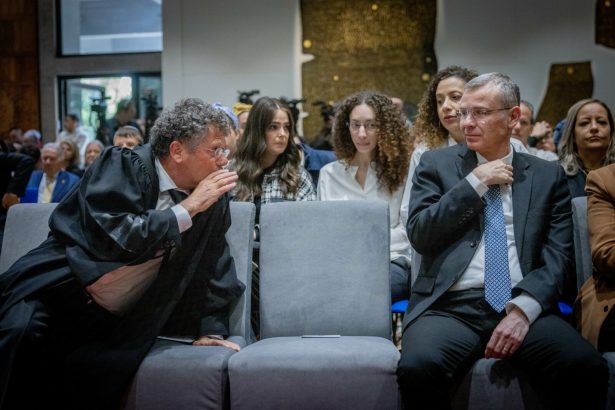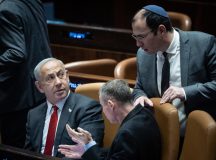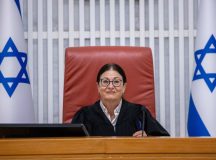Legal scholar Or Bassok takes a nuanced look at the Israeli Supreme Court’s ongoing battle with the Netanyahu government and its Justice Minister, Yariv Levin. Why, Bassok asks, has the court taken the dramatic step of proposing to hold Levin in contempt of court over a largely symbolic issue, when it has declined to do so in the case of the state’s failure to protect Palestinian villagers displaced from their homes by extremist settlers?
Motions for contempt of the court were requested in two recent cases before the Israeli Supreme Court due to failures to comply with the Court’s previous orders. Both motions were submitted against officials and organs of the Israeli government, which is a very rare occurrence. The basic expectation in a state governed by the rule of law is that the state’s various branches would obey court’s rulings without the threat of motions for contempt. Yet the handling of these two motions by the Court, the government, and Israeli society, as well as the outcomes of these two cases, diverge significantly. This divergence offers important insights into the Israeli legal discourse in this time period.
The first motion for contempt was against Justice Minister Yariv Levin for his failure – contrary to the Court’s ruling – to hold a vote in the Judicial Selection Committee on the appointment of the Court’s Acting President, Isaac Amit, to the role of the Court’s permanent president. Following the Court’s ruling on the motion, the Committee was convened without Levin, its chairperson, and the two other government representatives, and appointed Amit as the thirteenth president of the Court.
During the same period, another motion for contempt of the Court was submitted against the security forces for their continuing failure – also contrary to a Court ruling – to protect Palestinians who were displaced from their homes in the West Bank village of Khirbet Zanuta by a mob of extremist settlers. At the time of writing this post, the end result of this motion remains to be seen, as recent reports still indicate that the Palestinians cannot return to their homes and live there peacefully.
As will be elaborated below, these two cases are full of nuance and complexity. Yet they serve as a snippet of the reality the Israeli Supreme Court currently faces. The comparison of the two cases offers valuable insights into the long-lasting controversy over how courts should act in times of crisis.
One path for judges in times of crisis is to adhere to the wording of the law as a doctrinal shield to protect basic fundamental rights. Take, for example, the 1855 American case of a sixteen-year-old enslaved girl named Rosetta Armstead. After entering Ohio, she was declared free by a judge in a state court who read the Fugitive Act in a formalistic manner as not applying to a slave who was brought by her owner to Ohio, a state free of slavery. Simply put, voluntarily bringing a slave to a free state meant she was not a fugitive, so the Act could not apply to her. Adhering to ‘dry’ legal doctrine, judges succeeded in some cases in achieving a just result against a legal regime that made slavery lawful.
Another path for judges in a time of crisis is to take the ambitious role of judges as the guardians of the constitution. As an example of this function, scholars bring the lesson learned from the failed decision by the State High Court during the last days of the Weimar Republic. By adhering to the wording of the law rather than looking beyond the law in an attempt to save the Weimar democracy, the High Court refused to give an injunction preventing the Federal Government from taking over the local state powers of Prussia, the most powerful German state at that time. By doing so, the court prevented the Prussian anti-Nazi government from attempting to deal forcefully with Nazi violence and, moreover, consolidated the Federal government’s power, making the Nazi takeover easier once they won the 1933 elections. Following the defeat of the Nazis after World War II, the founders of the European Court of Human Rights envisioned it as an institution that acts beyond the role of merely a legalistic institution in the spirit of the Weimar State High Court. Instead, they promoted a court that should save democracy by issuing an injunction in a similar scenario and uniting all supporters of democracy behind it with strong declaratory judgments.
Israeli judges are hardly bound by oppressive legal doctrines as were judges in Antebellum America. Israel is also not close to the circumstances of the last days of the Weimar Republic. Just in January 2024, the Court was at the height of its powers when it declared itself as having the authority to strike down amendments to Israeli Basic Laws, which serve as Israel’s constitution. Having stated these caveats, in my concluding remarks, I use the examples of the two motions to reflect critically on the path the Court chose in dealing with these two cases in this time of crisis. I argue that the Court’s success in the appointment of the Court’s permanent President serves as a symbolic victory in its struggle against the government’s continuous attempt to overhaul the judicial system. Yet, at the same time, Israeli democracy is being hollowed as the Court fails to provide effective remedies in cases such as the one of the Zanuta villagers, in which simply insisting on the government’s duty to adhere to the rule of law would provide a remedy to concrete and harsh day-to-day violations of the most basic human rights.
Saving Israeli Democracy by Appointing the Court’s President
Since the retirement of the Court’s President, Esther Hayut, in October 2023, the Court has not had a president, only an acting president. Minister of Justice Yariv Levin refused to follow the convention, practiced since the Court’s establishment, according to which the Judicial Selection Committee appoints the Court’s longest-serving judge as the president. Instead, Levin sought to strike a ‘deal’ with the three Supreme Court judges serving on the Committee, which would include the appointment of Amit to the Court’s presidency in exchange for an agreement on appointing one of his candidates to one of the three vacancies on the Court.
While ‘deals’ on appointments to the Court were made in the past (though never so publicly), Amit was firm in insisting that his appointment to the presidency is a separate matter and should proceed with no connection to the vacancies on the Court. Amit had a tactical advantage, as only a simple majority in the committee (obtainable without the support of any of the representatives of the government) was required to ensure his appointment. However, there was deadlock for appointing any new judges to the Court, because these appointments require a supermajority of seven out of nine Committee members. This supermajority requires the three government representatives to cooperate with the three Supreme Court judges who sit on the Committee (without such cooperation getting seven votes is impossible).
Levin, who chairs the Committee, used numerous stalling tactics to avoid the vote on appointing Amit as the Court’s President. In response, in September 2024, the Court ruled in a petition against Levin (HCJ 1711/24) that while the minister, serving as the Committee’s chairperson, has discretion over when to call a vote, he cannot indefinitely postpone the vote on this issue. At the following Committee meeting, the judges walked out when they observed that Levin was once again using filibuster tactics to avoid a vote.
A few hours later, Amit gave a speech warning of the impending collapse of Israeli democracy. Such warnings have become a regular occurrence in recent decades, but this time, the warning was that the end was near, as the Court lacked a permanent president. As the acting president, Amit held all the authorities of the presidency, making the issue mostly a symbolic landmark in the continuing confrontation between the Court and the Netanyahu government. Minutes after the speech, three Court judges decided on a motion of contempt and ordered Levin to hold a vote on the appointment of the president within thirty days. Failure to do so meant he may be held in contempt. Naturally, after such a speech and the Court’s order, the media’s attention was focused on this confrontation. Yet even the Court, in all its decisions on this matter, could not point to any authority that the acting president lacked in comparison to a permanent president.
During those ensuing thirty days, several news reports surfaced, raising various allegations against Amit. Most of the allegations were minor or bogus, but one was substantial. In 2019, Amit failed to inform the judicial authority that the Tel Aviv Municipality had filed a criminal indictment against him as an apartment owner in a building. The indictment was minor and was later dismissed against all apartment owners, as is customary when violations are resolved. Yet, Amit should have reported the indictment to the judicial authority – the organisation that encompasses the court system – rather than remain quiet and enjoy the early retraction of the indictment once the municipality discovered that Amit was the defendant, thus requiring it to adhere to the rule which disallows indicting judges unless special authorisation is given.
On 26 January 2025, the Committee was convened. Levin, along with the two other coalition representatives on the committee, boycotted the meeting because it had not been postponed to allow further investigation of the allegations against Amit. In the meeting, Amit was appointed to the Court’s President by a vote of 5-0 (Amit did not participate in the vote).
The Court quickly dismissed a petition challenging the reasonableness of Amit’s appointment in view of the allegations against him. The Court did not even require a response from the respondents, and no oral hearing was held. The Court ruled that the petition did not satisfy the threshold requirement of establishing that the Court was the proper forum to discuss this subject matter (HCJ 17686/25). The judgment is at odds with the Court’s well-established jurisprudence in similar cases of appointment to high-level positions, where the Court has discussed the standards of behavior required for such appointments in considerable detail following lengthy oral hearings.
Minister of Justice Levin refused to acknowledge Amit’s appointment as the Court’s President, and there is currently a halt on the appointment of new Supreme Court judges, with no fewer than three vacancies. Still, Opposition Leader Yair Lapid welcomed Amit’s appointment, calling it “a victory for democracy,” and added that the “unnecessary delay” to the appointment “has caused enormous damage to the rule of law in Israel.”
The Displacement of the Zanuta Villagers
In November 2023, Palestinians from the village of Khirbet Zanuta, in the South Hebron Hills in the Occupied Territories, submitted a petition to the Supreme Court against the Israel Defense Forces, the Police, and the Ministry of Defense. In their petition, they claimed that they were constantly attacked in their homes by Jewish extremist settlers in a manner that prevented them from living in their small village. Several of the settlers involved in this violence were the subject of the Biden administration sanctions imposed in early 2024, which the Trump administration canceled. Sanctions by the UK government and the EU on these settlers remain in force.
In July 2024, the Court handed down a six-page judgment (HCJ 8117/23). This is not one of the symbolic judgments that the Court translates for foreign scholars to read. All translations from the judgment below are mine, and I have added annotations in brackets to clarify the text.
The part relevant to the subsequent request for contempt addressed the part in the petition that required the state to enforce the rule of law, thereby enabling the Zanuta villagers to return to their homes. The Court wrote that,
[t]he lawyer for the respondents [the government] declared that there is a willingness to do that [allow the villagers to return to their dwellings] in a date to be coordinated between the parties to the petitions. Under these circumstances, there is no need to rule on this issue… We assume that this would be done soon in accordance with the statement given.
The Court closed its judgment by stating:
-
- Before concluding, it is important to re-emphasise that on its face, the picture portrayed by the petitioners is disturbing, to say the least. In fact, from the respondents’ argument, one can understand that the state’s response [to the violence] was unsatisfactory, even if, according to their approach, everything possible was done. It is not superfluous to emphasise once more that the petitioners are protected persons [according to the laws of occupation] who are entitled to receive a proper response from the authorities in the occupied territories, and surely with regards to claims of persistent violence against them. Accordingly, the law enforcement forces in the occupied territories have the duty to protect the petitioners’ security and the public order in the occupied territories, even during the complicated circumstances of this period and even in view of their limitations. We believe that our judgment would sharpen this message.
- Given what was said thus far… it is clear that [the remedies ordered] do not provide a full response for the difficulties the petitions brought to the surface. One can only hope that the steps detailed above will give a first response to these difficulties.
In view of this mild rhetoric in comparison to the harsh statements in the decisions on the appointment of the Court’s president, it is perhaps not surprising that the villagers could not return to their homes due to the continuing violence of the settlers, with no proper response from the security forces. Hence, the request for contempt of the Court was heard on 6 January 2025, more than a year after the villagers’ displacement.
During the early days of January, the entire media was obsessed over the question of whether the Minister of Justice would convene the Committee to appoint the Court’s president to avoid an order of contempt. Experts continuously spoke on media outlets about the government ‘breaking the rule of law’ and the end of democracy if the minister failed to follow the Court’s order. However, no one discussed the breaking of the rule of law with regard to the government’s failure to comply with the Court’s order to return the Zanuta villagers to their homes. Indeed, hardly any media coverage was dedicated to the villagers’ petition.
The oral hearing before the Court in the motion for contempt in the Zanuta case was heated. Answering questions on why there were no indictments following the settlers’ violence, the police and the military argued that they are doing all they can, but the judges were dissatisfied with these answers in view of pictures showing settlers in the villagers’ homes.
The Court ruled that the government needs to first ‘coordinate the return of the petitioners to their village as soon as possible and no later than 16.2.2025.’ Second, ‘the police and the military must ensure, in a continuous manner and with due persistence, the removal of invaders from the village territory and the private-owned land.’
No threat of contempt of the Court was made in the Court’s decision, as was done against the Minister of Justice. At the time this post is written, news reports in Hebrew and English, as well as my correspondence with one of the reporters who follows the situation on the ground, indicate that the Court’s ruling has yet to be fulfilled.
Conclusion: Contempt of the Rule of Law
Every stone you kick in the land on which Jews and Palestinians have been fighting for over a century has a history stretching over thousands of years, and the area of south Hebron is no exception. Some of the Palestinians in this area are from the Makhamra family. Historians have a strong argument that this family descended from a Jewish tribe that Mohamed expelled from the Arabian Peninsula. After the 1967 War, there was much interest from Israelis in this tribe. Yet, it did not help in creating a common understanding that all inhabitants of the land share a common father – Abraham – and a common bloodline. Now, all that is left is bloodshed.
There is no doubt the current Israeli government exhibits an unprecedented contempt towards the rule of law. The source of this contempt is in part due to its extremist nature. Before becoming members of the current coalition government, a few of its members were associated with the Kach racist movement, which is outlawed as a terrorist organisation. In the past, anyone connected to this movement was an outcast in Israeli public discourse, but not anymore. Yet, this is only part of the picture. Changes in the Court’s jurisprudence have also contributed to a growing contempt among the Israeli public for the rule of law. It is on this contempt that the government is relying in its campaign against the Court.
The only case in which the Court ever ordered the government to evacuate a settlement and return the land to its Palestinian owners occurred in the 1979 Elon Moreh case (HCJ 390/79). In his judgment, Deputy President Moshe Landau wrote that because the settlement’s land was claimed to be required for military needs, it could not be used for building a civilian settlement. Landau’s judgment was based on a legal doctrine that does not examine Palestinians’ rights. Instead, his judgment focused on the flawed process that led to the decision to build the settlement. Landau based his judgment on the illegality of building the Elon Moreh settlement for civilian purposes while the government used security claims to seize the land in order to comply with the law of occupation.
In 2000, eighteen years after retiring from the Court, Landau gave his first media interview which reflected his political opinions. It revealed his firm belief that the final goal of Arabs is to destroy the state of Israel. In his view, peace between Jews and Palestinians would never be achieved. In the same interview, he said that under the leadership of Judge Aharon Barak, the Court had become a Platonic philosopher king ruling on issues of final values and identity with no basis in the law rather than fulfilling its chief role of enforcing the rule of law.
Born in Danzig in 1912, Landau left Germany in 1930 but was one of the many Israeli judges who were haunted by the Weimar lessons. He served as one of the judges in the Eichman trial and impressed Hannah Arendt immensely. In contrast to the vision of courts as the guardians of democracy, the lessons he took from Weimar was that the Court must strictly adhere to its role as a legal expert and avoid, as much as possible, contested value questions such as determining Israeli identity. He opened his Elon Moreh judgment, noting that while the public may not understand the legal reasoning and thus the Court’s public confidence may be hindered, the role of the Court is to follow the law.
The right-wing Likud Government headed by Prime Minister Menachem Begin obeyed the Elon Moreh judgment and used the armed forces to confront frustrated settlers. Begin famously said after the judgment: ‘indeed, there are judges in Jerusalem.’ At that time, the Court was conceived as an expert, just like the central bank, and who would not listen to experts in economics or the law? Relying on its doctrinal legal expertise, in the Elon Moreh case, the Israeli Court understood Alexander Hamilton’s insight that
[t]he judiciary… has no influence over either the sword or the purse…It may truly be said to have neither Force nor Will, but merely judgment; and must ultimately depend upon the aid of the executive arm even for the efficacy of its judgments.
Contrary to Hamilton, who spoke of the judiciary as having ‘merely judgment,’ in 1986, Judge Barak began incorporating an idea he had imported from American Justice Frankfurter: that the Court has merely ‘public confidence’. In a 1962 judgment, Frankfurter paraphrased Hamilton but replaced the notion that judiciary relies on its expertise with the idea that it relies on its public support. Frankfurter wrote that ‘[t]he Court’s authority – possessed of neither the purse nor the sword – ultimately rests on sustained public confidence in its moral sanction.’
The majority of the Israeli Court judges adopted the idea that the Court’s source of legitimacy is to be understood in terms of public confidence. This understanding of judicial legitimacy allowed the Court to adjudicate questions that were beyond its legal doctrinal expertise, such as determining the content of Israel’s identity.
But such a shift in understanding its source of legitimacy came with a hefty price. First, the Court became dependent on its public confidence, and symbolic cases that may affect this support have become central to the Court. After all, beyond the need to achieve a symbolic ‘victory,’ nothing was at stake in the petition for appointing Amit to President. The only thing the Court achieved from this confrontation was demonstrating to Levin and the public that it holds the final word.
Second, relying on public confidence has allowed the Court to expand its wings to questions such as whether the Court has the power to strike down constitutional amendments based on the identity of the state as Jewish and democratic (it does) or whether the identity of Israel as the nation-state of the Jewish people adheres to its definition as Jewish and democratic state (it does). Yet, it has eroded the Court’s ability to follow the legal-doctrinal path of the Landau Court. After decades of speaking to the public on balancing between values and identity issues, there is no viable language of doctrinal expertise for the Court to fall back upon.
The comparison between the cases of the Zanuta villagers and the appointment of the Court’s President is telling. However, it is merely one example of the gap between how the Court is vigilant in maintaining its symbolic status as the final arbiter in constitutional controversies while at the same time being unable to fulfill its role of enforcing the rule of law in its most basic sense.




































